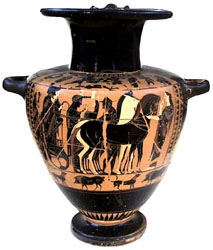 The black-figure technique for figure and subsidiary decoration on vases involves the painting of a silhouette, often after preparation by roughly painted guide lines. Details are added by incision which shows the paler clay beneath. There may then be some added colour - red for some dress or body areas on animals, or to pick out leaves on palmettes; and white for patterns and women's flesh. The technique was adopted first in Corinth by about 700 BC, inspired probably by incised figures observed on eastern bronzes and ivories. The last main use was in Athens in the early 5th century, though it persisted for some traditional wares, such as the Panathenaic amphorae.Through the 6th century it was adopted by many regional wares in Greece.
The black-figure technique for figure and subsidiary decoration on vases involves the painting of a silhouette, often after preparation by roughly painted guide lines. Details are added by incision which shows the paler clay beneath. There may then be some added colour - red for some dress or body areas on animals, or to pick out leaves on palmettes; and white for patterns and women's flesh. The technique was adopted first in Corinth by about 700 BC, inspired probably by incised figures observed on eastern bronzes and ivories. The last main use was in Athens in the early 5th century, though it persisted for some traditional wares, such as the Panathenaic amphorae.Through the 6th century it was adopted by many regional wares in Greece.
Above: Typical example of black-figure technique. Attic hydria. Oxford. Ashmolean Museum 1965.119. Photo. Beazley Archive. © Beazley Archive, Ian Hiley